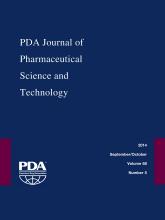Abstract
A number of rapid microbiological methods capable of aerosol-based microbial detection are quickly emerging for use in the pharmaceutical and food markets. A subset of these technologies utilizes intrinsic microbial fluorescence as the basis for bioaerosol detection. This fundamental method of detection is relatively new to the pharmaceutical and food industries, which rely on traditional culture-based methods implemented decades ago to gain an understanding of their manufacturing environments. When combined with real time and continuous assessment, intrinsic fluorescence-based detection provides a new level of information and monitoring in these environments. One aspect of this monitoring relates to the detection of stressed micro-organisms. Bacteria found in pharmaceutical and food manufacturing environments can be in a stressed state due to heat, UV, or chemical exposure, desiccation, and so forth. As a result, the ability of an environmental monitoring system to detect stressed microbes is of particular interest. A commercially available, intrinsic fluorescence-based bioaerosol detection RMM was utilized in this study to determine the ability of such systems in the detection of heat-stressed microorganisms. An assessment of culturability and growth delay in control and heat-stressed samples was performed to confirm stress. Furthermore, the performance of the intrinsic fluorescence-based bioaerosol detection systems were compared to the SAS Super 100, MAS-100 NT, and SMA air samplers in the detection of heat-stressed Escherichia coli, Staphylococcus epidermidis, and Bacillus atrophaeus spores. These bacteria were selected because they are industry-relevant organisms, commonly found in various manufacturing environments, that represent a Gram-positive, Gram-negative, and spore-forming bacteria, respectively. It was found that the intrinsic fluorescence-based bioaerosol detection systems can detect heat-stressed microorganisms, including those that are not detected by the traditional culture-based method due to the inability of the stressed microbes to form colony-forming units.
LAY ABSTRACT: Rapid microbiological methods capable of aerosol-based microbial detection are emerging for use in pharmaceutical and food markets. A subset of these technologies utilizes intrinsic microbial fluorescence as the basis for bioaerosol detection, a method relative new to the pharmaceutical and food industries, which rely on traditional culture-based methods. Bacteria found in such environments can be in a stressed state due to heat, UV, or chemical exposure, desiccation, and so forth. As a result, the ability of an environmental monitoring system to detect stressed microbes is of particular interest. A commercially available, intrinsic fluorescence-based bioaerosol detection RMM was utilized in this study to determine the ability of such systems in the detection of heat-stressed microorganisms. An assessment of culturability and growth delay in control and heat-stressed samples was performed to confirm stress. Furthermore, the performance of the intrinsic fluorescence-based bioaerosol detection systems were compared to the SAS Super 100, MAS-100 NT and SMA air samplers in the detection of heat-stressed Escherichia coli, Staphylococcus epidermidis, and Bacillus atrophaeus spores. These bacteria were selected because they are industry-relevant organisms, commonly found in various manufacturing environments, that represent a Gram-positive, Gram-negative, and spore forming bacteria, respectively. It was found that the intrinsic fluorescence-based bioaerosol detection systems can detect heat-stressed microorganisms, including those that are not detected by the traditional culture-based method due to the inability of the stressed microbes to form colony-forming units.
Footnotes
IMD-A is a registered trademark or trademark of U.S.-based Azbil BioVigilant, Inc. in the United States and other countries.
- © PDA, Inc. 2014
PDA members receive access to all articles published in the current year and previous volume year. Institutional subscribers received access to all content. Log in below to receive access to this article if you are either of these.
If you are neither or you are a PDA member trying to access an article outside of your membership license, then you must purchase access to this article (below). If you do not have a username or password for JPST, you will be required to create an account prior to purchasing.
Full issue PDFs are for PDA members only.
Note to pda.org users
The PDA and PDA bookstore websites (www.pda.org and www.pda.org/bookstore) are separate websites from the PDA JPST website. When you first join PDA, your initial UserID and Password are sent to HighWirePress to create your PDA JPST account. Subsequent UserrID and Password changes required at the PDA websites will not pass on to PDA JPST and vice versa. If you forget your PDA JPST UserID and/or Password, you can request help to retrieve UserID and reset Password below.






